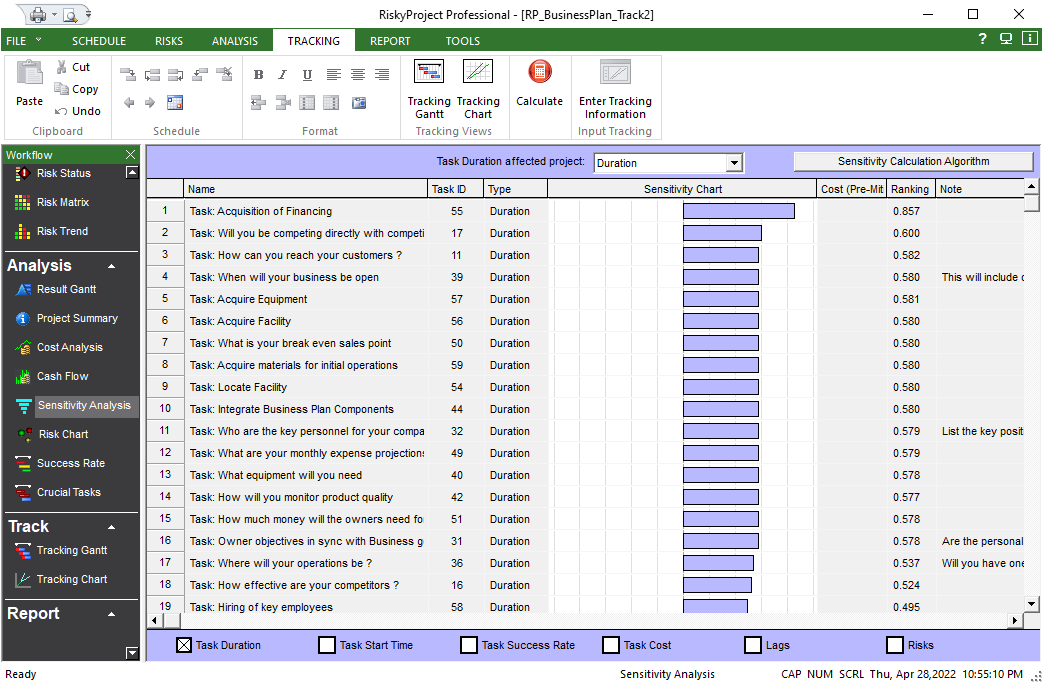What is Sensitivity Analysis?
Sensitivity analysis is the quantitative risk assessment of how changes in a specific model variable impacts the output of the model. It is also a key result of Monte Carlo simulations of project schedules. Often referred to as a Tornado chart, sensitivity analysis shows which task variables (Cost, Start and Finish Times, Duration, etc) have the greatest impact on project parameters.
In projects, we are looking at how uncertainties and risks assigned to specific activities correlate with variance in the project. For example, sensitivity analysis allows you to identify which task’s duration with uncertainty has the strongest correlation with the finish time of the project. It answers the question, which task inputs have the greatest impact on the key project objectives. This in turn provides clues to where project managers should look first when a management decision is required.
Spearman Rank Order Method
For schedule risk analysis, Spearman rank order is a statistical method that generates a correlation coefficient from 0 to +1 where a score of 1 is a perfect correlation between the input and the output. In other words, it measures the strength of the relationship between the input and output variables. For example, you would like to know how the changes in the cost of a particular material impacts the overall cost of a project and identify those which cause the greatest variance in the projects.
Sensitivity Analysis in Project Management
In a very simple example, you have 2 materials with their most likely estimated low and high ranges
- Material A: $1000 ($750 – $1500)
- Material B: $10,000 ($9950 – $10, 100)
- Total Base Cost is $11, 000
We want to understand how variances in the cost of specific materials impacts the variance of the total project costs. If we can identify what is causing the most cost variance, it may be possible to manage this risk in such a way to provide higher level of confidence in the expected cost of the project.
If we run a Monte Carlo risk analysis, we will see that expected cost can range from a low of $10,500 and a high of $12000, a $1500 possible variance. the goal of the sensitivity analysis is not to identify which input “costs” the most, but which one has strongest relationship between the its cost and the $1500 range we get from the results of the simulation. In a very simple example like the one above the answer is obvious and we get a correlation of .998 % between the cost of material A and Total Project Cost. The cost of material B, even though it is much higher, only has a correlation of .05 %. So if we want to improve cost surety, we should focus on minimizing the variance in material A. A possible management strategy would be to purchase all materials in advance for a slightly higher guaranteed price.
Sensitivity Analysis in RiskyProject
In RiskyProject, the Spearman rank order correlation is used extensively not only to for sensitivity analysis, but also incorporated into the calculation of risk scores are scored, and cruciality and success rate analysis.
In RiskyProject, you can view the results of the sensitivity analysis in the Sensitivity Analysis view. You can view the sensitivity analysis for all project parameters Duration, Cost, Finish Time, and Success Rates as well as for each risk category. The analysis includes allows you to look at sensitivity for each of the above parameters for Task Duration, Task Start Time, Task Success Rate, Task Cost, Lags, and Risks. In addition, you can view the sensitivity for Task Finish Time for tasks using the Tornado Plot which can be found in most of the Analysis views.
Sensitivity Analysis view in RiskyProject





